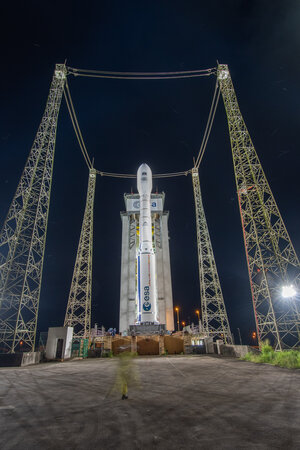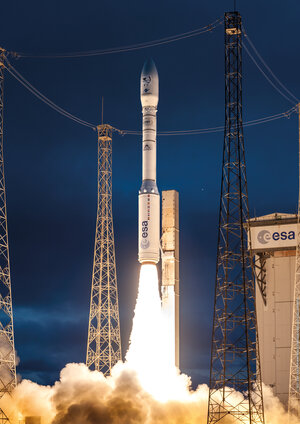Vega-C inaugural flight VV21 media kit
Download this media kit (EN, DE, ES, FR, IT) to learn more about ESA’s new launch system and its inaugural mission. Flight VV21 is scheduled for lift-off as soon as 13 July at 13:13 CEST, pending suitable conditions for launch.

This is an interactive media kit. Navigate between pages from the contents page or with the arrows at the bottom of each page. Links to download infographics, images and videos are provided towards the end of this launch kit. An internet connection is required to access the external webpages.
Vega-C represents a dramatic capability boost compared to its predecessor, Vega, which has flown since 2012. With new first and second stages and an uprated fourth stage, Vega-C increases performance from Vega’s 1.5 t to about 2.3 t in a reference 700 km polar orbit.
A larger fairing doubles available payload volume, and the improved re-ignitable upper stage has increased liquid propellant capacity, to deliver payloads to multiple orbits and extend mission duration when required. ESA’s upcoming Space Rider return-to-Earth vehicle will be launched to orbit on Vega-C.
The main payload on VV21 is LARES-2, a scientific mission of the Italian Space Agency (ASI). Once in orbit, LARES-2’s precise path will be tracked by laser, from ground stations, to measure the so-called frame-dragging effect, a distortion of space-time caused by the rotation of a massive body such as Earth as predicted by Einstein’s General Theory of Relativity. Its predecessor, the similar LARES, was the main payload on the 2012 inaugural flight of Vega.
Six CubeSats make a secondary payload package.















 Germany
Germany
 Austria
Austria
 Belgium
Belgium
 Denmark
Denmark
 Spain
Spain
 Estonia
Estonia
 Finland
Finland
 France
France
 Greece
Greece
 Hungary
Hungary
 Ireland
Ireland
 Italy
Italy
 Luxembourg
Luxembourg
 Norway
Norway
 The Netherlands
The Netherlands
 Poland
Poland
 Portugal
Portugal
 Czechia
Czechia
 Romania
Romania
 United Kingdom
United Kingdom
 Slovenia
Slovenia
 Sweden
Sweden
 Switzerland
Switzerland

































